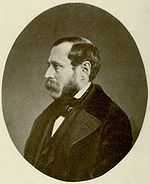Jean Stas
| Jean Stas | |
|---|---|
|
Jean Stas | |
| Born |
August 21, 1813 Leuven |
| Died | December 13, 1891 |
| Nationality | Belgian |
| Fields | Chemistry |
| Known for | Accurate determinations of atomic weights |
| Influences | Jean-Baptiste Dumas |
| Notable awards | Davy Medal (1885) |
Jean Servais Stas (August 21, 1813 - December 13, 1891) was a Belgian analytical chemist.
Life and work
Stas was born in Leuven and trained initially as a physician. He later switched to chemistry and worked at the École Polytechnique in Paris under the direction of Jean-Baptiste Dumas. Stas and Dumas established the atomic weight of carbon by weighing a sample of the pure material, burning it in pure oxygen, and then weighing the carbon dioxide produced.
In 1840, Stas was appointed professor at the Royal Military School in Brussels. He acquired international fame by determining the atomic weights of the elements more accurately than had ever been done before, using an atomic mass of 16 for oxygen as his standard. His results disproved the hypothesis of the English physicist William Prout that all atomic weights must be integral multiples of that of hydrogen. These careful, accurate atomic weight measurements of Stas helped lay the foundation for the periodic system of elements of Dmitri Mendeleev and others.[1]
Following the pioneering work of Lavoisier and his statement of the conservation of mass, the prolonged and exhaustive experiments of Stas supported the strict accuracy of this law in chemical reactions,[2] even though they were carried out with other intentions. His research[3][4] indicated that in certain reactions the loss or gain could not have been more than from 2 to 4 parts in 100,000.[5] The difference in the accuracy aimed at and attained by Lavoisier on the one hand, and by Morley and Stas on the other, is enormous.[6]
In 1850 Stas gave the evidence that the Belgian Count Hippolyte Visart de Bocarmé killed his brother-in-law by poisoning with nicotine.[7]
Stas retired in 1869 because of problems with his voice caused by a throat ailment. He became commissioner of the mint, but resigned in 1872 because he disagreed with the government's monetary policy. Jean Stas died in Brussels and was buried at Leuven.
Honors and awards
- Foreign Member, Royal Society of London (1879)
- Davy medal (1885)
Selected writings
- Stas, Jean Servais (1894). L. W. Spring, ed. Œuvres Complètes 1. Brussels.
- Stas, Jean Servais (1894). J. B. Depaire, ed. Œuvres Complètes 2. Brussels.
- Stas, Jean Servais (1894). L. W. Spring, ed. Œuvres Complètes 3. Brussels.
See also
Further reading
- Morley, Edward W. (1892). "Jean Servais Stas". Journal of the American Chemical Society (American Chemical Society) 14 (7): 173–189. doi:10.1021/ja02123a012.
- Timmermans, Jean (1938). "Jean Servais Stas". Journal of Chemical Education 15 (8): 353–357. Bibcode:1938JChEd..15..353T. doi:10.1021/ed015p353.- translated into English by Ralph Oesper
References
- ↑ Rawson, Don C. (1974). "The process of discovery: Mendeleev and the periodic law". Annals of Science 31 (3): 181–204. doi:10.1080/00033797400200221.
- ↑ Matthew Moncrieff Pattison Muir, The Elements of Chemistry (1904)
- ↑ Nouv. Recherches sur los lois des proportions chimiques (1865) 152, 171, 189
- ↑ "Conservation of Mass in Chemical Changes"Journal - Chemical Society, London, Vol.64, Part 2 Chemical Society (Great Britain)
- ↑ William Edwards Henderson, A Course in General Chemistry (1921)
- ↑ Ida Freund, The study of Chemical Composition: an account of its method and historical development, with illustrative quotations (1904)
- ↑ Wennig, Robert (April 2009). "Back to the roots of modern analytical toxicology: Jean Servais Stas and the Bocarmé murder case". Drug Test Anal (England) 1 (4): 153–5. doi:10.1002/dta.32. PMID 20355192.
| Wikimedia Commons has media related to Jean Servais Stas. |
|
